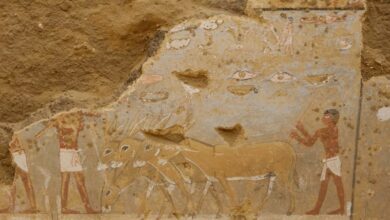
Scientists have identified and recreated the scent used to preserve the remains of an Egyptian noblewoman mummified in 1450 BC, the Daily Mail reported, with the aroma called “the scent of eternity.”
Advanced chemical analysis technology made it possible to recreate the smell of the embalming fluid used to preserve the mummy found at the Valley of the Kings in Luxor.
Named Senetnay, the mummy lived 3,500 years ago and had breastfed King Amenhotep II during his infancy, the paper reported, adding that she was known as “Ornament of the King”.
The perfume contains a complex mixture of ingredients – from vanilla-like coumarin, sweet anti-bacterial beeswax, the odor of a resin similar to pine-tree and benzoic acid sourced from plants such as cinnamon and cloves.
But the odor also features a distinct aroma similar to modern asphalt roads, the result of the bitumen in mummification to insulate organs from moisture and insects.
As ancient Egyptian texts are scarce on the exact ingredients used in embalming perfumes, modern day scientists have had to use state-of-the-art analysis to examine the materials.
A smell of history
‘The scent of eternity‘ will be displayed at the Moesgaard Museum in Denmark in an upcoming exhibition, allowing visitors a unique chance to get a whiff of the ancient Egyptian mummification process.
The scent was recreated by taking samples from two jars containing Senetnay’s liver and lungs, exhumed from the famous Valley of the Kings by archaeologist Howard Carter over a century ago.
The scientists divided the embalming fluid into individual molecules using processes such as chromatography, which bombards materials with gases to separate it into smaller parts.
They worked closely with French perfumer Carole Calvez and sensory museum scientist Sofia Collette Ehrich to revive the ancient scent.
The researchers described the six complex components of embalming fluid in the journal Scientific Reports, which reveal the truly exceptional status Senetnay held in life – as also demonstrated by her burial at the Valley of the Kings, which was reserved for ancient Egypt’s more powerful royalty.
“These results show how advanced the Ancient Egyptian mummification process was – but recreating the scent of eternity is also like a time machine,” the Daily Mail quoted Barbara Huber, who led the study from the Max Planck Institute of Geoanthropology.
“People are used to looking at mummies and reading museum descriptions, but this helps them to actually experience how the past smelled,” she added.
“The scent of eternity represents more than just the aroma of the mummification process. It embodies the rich cultural, historical, and spiritual significance of Ancient Egyptian mortuary practices.”
Trade secrets
One interesting discovery from this find is the indication that Egypt may have been practicing international trade about 1,000 years earlier than previously thought.
Previously, Peppercorns found in the nose of Pharaoh Ramses II suggested trade with southern India, as these peppercorns were only found there. Now a fragrant, gummy resin called ‘dammar’ believed to have been found in Senetnay’s embalming fluid suggests that international trade could have existed 250 years before that of Ramses II.
The source of the dammar resin is likely from the dipterocarp trees that grow in Southeast Asia. If verified, this indicates that ancient Egyptians were able to reach Southeast Asia approximately a thousand years earlier than previously assumed.




